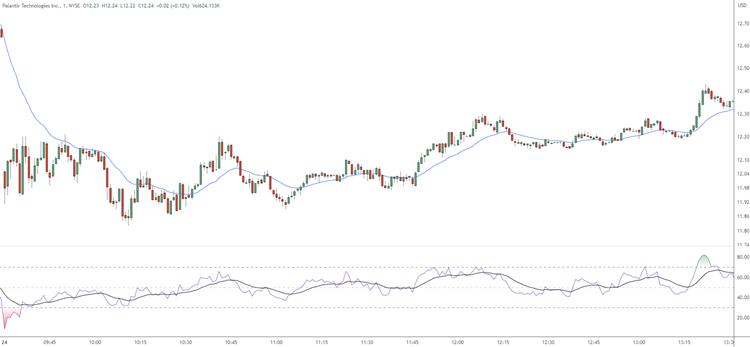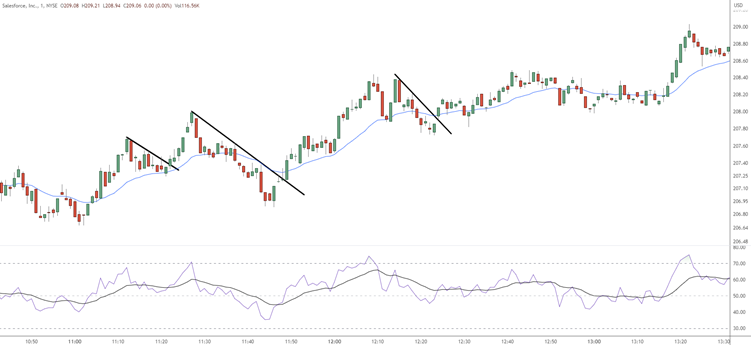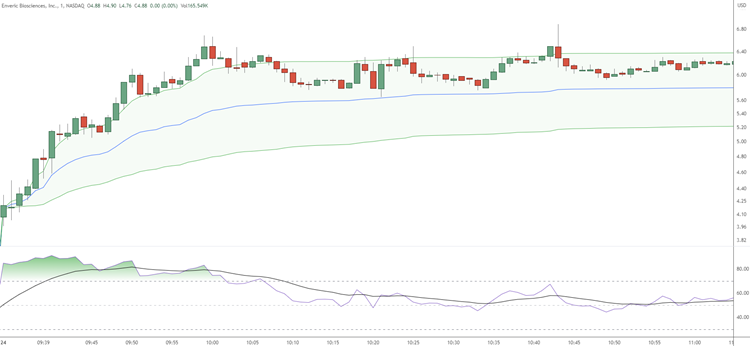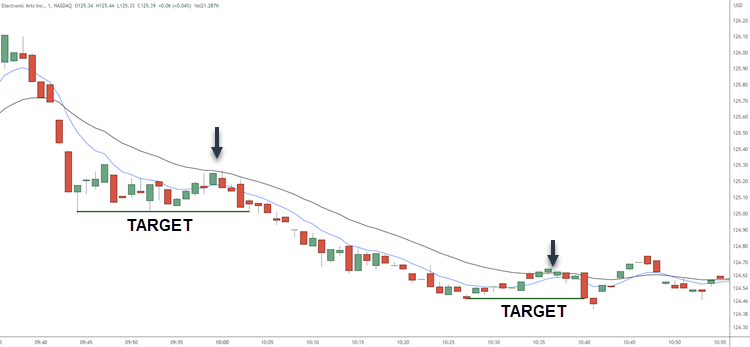- August 14, 2023
- Posted by: CoachShane
- Categories: Day Trading, Stock Trading, Trading Article

The 1-minute scalping strategy is a strategy designed to capitalize on small price movements using a 1-minute chart, selecting volatile stocks, and relying on technical indicators for quick entry and exit points during high-volume hours.
 1-Minute Scalping is a popular day trading strategy that involves making rapid trades in short timeframes, taking advantage of small price movements in the market.
1-Minute Scalping is a popular day trading strategy that involves making rapid trades in short timeframes, taking advantage of small price movements in the market.
With a focus on trend-following and pattern recognition, 1-Minute Scalping requires a sharp eye for detail and an ability to act fast.
From identifying bullish and bearish flags to leveraging volume weighted average price (VWAP), we will guide you through the process of successful scalping. With tips on managing risk and reward, you will be equipped to navigate the fast-paced world of 1-Minute Scalping with confidence.
Mastering 1-Minute Scalping: A Popular Day Trading Strategy
You might be thinking that day trading is too risky, but with the right strategy and mindset, mastering a 1 minute scalping strategy can be a profitable way to trade.
One key that successful scalpers master in, is identifying effective entry points. This means looking for areas where there are strong levels of support or resistance, as well as paying attention to technical indicators such as moving averages and stochastic oscillators.
Another important factor to consider when practicing 1-minute scalping is the psychology of scalping itself. This type of trading involves quickly entering and exiting positions, which can be mentally demanding and require discipline and focus.
It’s important to understand how to scalp in volatile markets, where prices may fluctuate rapidly and unpredictably. By staying calm under pressure, using risk management techniques like stop-loss orders, and having a solid understanding of market price movements, you can master the art of minute scalping for consistent profits.
Power of Trend-Following
Trend analysis is a crucial component of 1-minute scalping, as it helps traders identify the direction of price movements and make better decisions about when to enter or exit a trade.
By analyzing price trends over short timeframes, traders can capitalize on small price fluctuations and generate consistent profits. Technical indicators and price action techniques can also be used to enhance trend analysis in 1-minute scalping.
 Moving averages can help traders identify support and resistance levels, while oscillators like the Relative Strength Index (RSI) can indicate whether a market is overbought or oversold.
Moving averages can help traders identify support and resistance levels, while oscillators like the Relative Strength Index (RSI) can indicate whether a market is overbought or oversold.
Combining these tools with trend analysis can provide a powerful framework for capturing quick profits in volatile markets.
Bullish and Bearish Flags
Bullish flags occur when a price consolidates after an upward trend, forming a rectangular shape that slopes against the trend. This indicates a pause before continuing the uptrend. To confirm the pattern, look for low trading volume during the flag formation and a breakout above resistance.
 Bearish flags are the opposite and form when prices consolidate after a downward trend into a rectangular shape that slopes against it. This indicates that sellers are taking a break before resuming their selling activity.
Bearish flags are the opposite and form when prices consolidate after a downward trend into a rectangular shape that slopes against it. This indicates that sellers are taking a break before resuming their selling activity.
To confirm this pattern, watch for low trading volume during consolidation and then wait for prices to break below support once again.
Both bullish and bearish flags can be invalid if there is not enough volume during or after the break and if prices do not break out as expected.
Identifying Continuation and Reversal Patterns
Identifying key levels is a good strategy when scalping a 1-minute chart as it helps you identify where the price may continue or reverse.
Key levels are significant support and resistance levels, trend lines, and moving averages. These levels act as a guide for traders to determine their entry and exit points.
Using technical indicators can also help you identify potential continuation or reversal patterns. Momentum indicators such as the Stochastic Oscillator can indicate whether the market is overbought, or oversold, which could signal a potential reversal.
Trend-following indicators such as Moving Average Convergence Divergence (MACD) can help identify trends and potential continuations.
However, even with these tools at your disposal, managing emotions and discipline is still essential for successful 1-minute scalping. It’s easy to get caught up in the fast-paced environment of scalping, but it’s important to remain disciplined in your trading strategy.
Emotions such as fear or greed will cloud your judgment and lead to impulsive decisions that will result in losses. By sticking to a well-defined trading plan and being aware of your emotions, you increase your chances of success in this high-speed trading style.
Volume Weighted Average Price (VWAP)
Using VWAP as a trading indicator can help you determine whether a stock is overbought or oversold, and can also give you an indication of its trend direction. By incorporating VWAP into your scalping strategy, you’ll have a better idea of when to enter and exit trades.
 Scalping with price action is another important aspect in all time frames. This involves identifying key support and resistance levels, using technical indicators such as moving averages, and analyzing candlestick patterns. By combining these techniques with VWAP, you’ll be able to line up more factors to help you decide about which trades to take and when.
Scalping with price action is another important aspect in all time frames. This involves identifying key support and resistance levels, using technical indicators such as moving averages, and analyzing candlestick patterns. By combining these techniques with VWAP, you’ll be able to line up more factors to help you decide about which trades to take and when.
It’s important to stay up-to-date on news events that could affect the markets. Incorporating news events into your strategy can help you anticipate market movements, especially adverse events and capitalize on them for profitable trades.
Why the 1-Minute Timeframe is Ideal for Scalping
When it comes to scalping, time is our friend or our enemy. The goal is to make quick profits by buying and selling within a short period. This means that traders need to be able to make trade entry decisions quickly and accurately.
The 1-minute timeframe allows traders to see price movements unfolding quickly, giving them a better understanding of market sentiment.
 One of the benefits of scalping on a 1-minute timeframe is that it allows traders to take advantage of small price movements and quick profit targets. These small movements may not be significant on longer timeframes but can result in substantial profits when traded correctly.
One of the benefits of scalping on a 1-minute timeframe is that it allows traders to take advantage of small price movements and quick profit targets. These small movements may not be significant on longer timeframes but can result in substantial profits when traded correctly.
Scalping requires a certain level of discipline and psychology. Traders must be able to control their emotions and stick to their strategy even during times of high volatility. Technical indicators such as moving averages, Bollinger Bands, and Relative Strength Index (RSI) can also help traders identify potential entry and exit points for trades on this timeframe.
1 Minute Chart Scalping Ideas
| Strategies | Description |
|---|---|
| Choose the Right Stocks | Scalping requires high liquidity and volatility. Choose stocks that have a high average daily trading volume. Also, stocks with significant news or earnings reports can be good candidates due to the increased volatility. |
| Use a 1-Minute Chart | Set your chart to a 1-minute timeframe. This will allow you to see price changes in real-time giving you strong trade entries. |
| Use Technical Indicators | Use indicators like Moving Averages (exponential moving averages when scalping), Bollinger Bands, and Relative Strength Index (RSI). A common setup might be to look for stocks that are trading within a narrow Bollinger Band range and then buy or sell when the price breaks out of this range. |
| Entry and Exit Points | Decide on your entry signal and sell signals before you make a trade. A common strategy is to buy when the price breaks above the upper Bollinger Band and sell when it falls below the lower Bollinger Band. You could use the RSI to identify overbought and oversold conditions. |
| Set a Stop-Loss Order | Always set a stop-loss order to manage your risk. This is a predetermined point at which you will sell the stock to limit your loss if the trade goes against you. |
| Take Profits Quickly | The goal of scalping is to make many small profits throughout the day. Don’t get greedy and hold on for a big win. Take your profit as soon as you see momentum start to die off. |
| Trade During Peak Hours | The best time for scalping is during high volume hours, typically the first and last hour of the trading day. |
Risk and Reward: Managing Capital
As a minute scalper, it’s crucial that you have a risk management plan in place. You need to be aware of the potential risks involved and have strategies in place to mitigate them.
Maximizing profits shouldn’t come at the expense of taking on excessive risk. One important aspect of managing your capital is using position sizing techniques. This is determining how much capital you should allocate per trade based on your account size and overall risk tolerance.
By using proper position sizing, you can limit the amount of loss on any given trade while still allowing for potential gains. Having stop-loss orders in place can help prevent large losses if the market moves against your positions.
By implementing effective risk management strategies such as these, you can increase your chances of long-term success as a minute scalper. Since these are short term trades, you will only have risk on for a limited period of time.
Trading Fees and Expenses
When scalping and going for smaller profit targets, ensure that you are trading in a low commission environment. Commissions for trading vary from broker to broker so ensure you shop around. If scalping Forex, ensure you stick with major currency pairs and tight spreads. In FX, look to take profit targets at 10-15 pip gain as a rule of thumb.
Frequently Asked Questions
Which indicator is most effective for 1 minute scalping?
The stochastic oscillator is a popular choice for 1 minute scalping due to its sensitivity to short-term market movements.
What is the optimal strategy for successful 1 minute scalping?
A successful 1 minute scalping strategy involves identifying key support and resistance levels, using tight stop-losses, and taking quick profits.
Can 1 minute scalping give profitable results?
Yes, 1 minute scalping can be profitable if executed with discipline and a sound strategy.
Which currency pairs are ideal for 1 minute scalping?
Major currency pairs such as EUR/USD, USD/JPY, and GBP/USD are ideal for 1 minute scalping due to their high liquidity and low spreads.
Is there a preferred timeframe for scalping?
The 1 minute timeframe is the preferred timeframe for scalping as it allows for quick trades and high-frequency trading.
What is the most reliable EMA for 1 minute charts?
The 8 and 21 period EMAs are commonly used on 1 minute charts as they provide a good balance between sensitivity and reliability.
Is scalping more challenging than day trading?
Scalping can be more challenging than day trading due to the need for quick decision-making and the pressure to constantly monitor the market.
Conclusion
With the right mindset, tools, and strategies, you can turn this fast-paced style of trading into a profitable venture and successful trading career.
By mastering trend-following techniques, recognizing bullish and bearish flags, identifying continuation and reversal patterns, leveraging VWAP, and managing risk effectively, you can optimize your chances for success with a 1-minute scalping strategy.
Remember to stay focused on your targets and minimize emotional reactions to market fluctuations. With practice, perseverance and with dozens of trades under your belt, you could be on the road to successful trading.
